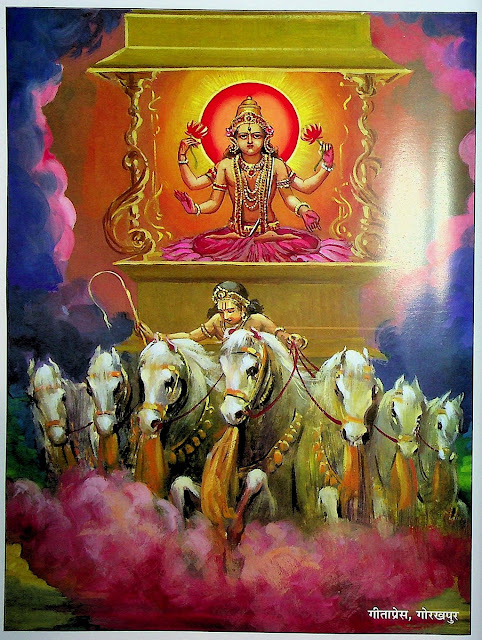 |
| Aruna driving Surya's chariot. (Credit: Bhavishya Puran Gita Press Gorakhpur) |
Aruna is the charioteer of Sun god Surya. He is the son of sage maharishi Kashyapa and his mother was Vinata. His brother is Garuda, the mount of lord Vishnu. You can read the interesting story of his birth, his sons, and other interesting anecdotes in the Story of Garuda, the mighty king of birds.
Aruna was born prematurely with only the top half of his body fully formed while his lower half was not fully developed. He was blessed by his father to be the charioteer of the Sun god Surya.
A legend goes that the demon Rahu attacked the Sun regularly. This used to cause surya grahan or the solar eclipse. You can read more about eclipses in Story of Grahan, swallowing of the Sun & Moon by asura Rahu Ketu. With repeated attacks, Surya became angry and the Sun started to burn intensely. The radiating heat was so intense that it could destroy all living beings and dry all the water bodies. Lord Brahma, the creator, instructed Aruna to take his chariot on a different route every day which would bring relief to the living. Thus we have the Sun move across the sky in a slightly different path every day. When Surya's chariot goes over you, we have the hot summer season. When Aruna takes a route away from you it causes the winter season. Every day of the year has a different length of the day from sunrise to sunset. This is how Surya’s intense heat is not concentrated in only one place.
Another legend is about Aruna wanting to visit the assembly of celestial apsaras. As no man other than Indra could enter this assembly, Aruna took a female form of Aruni and went there one night. Indra fell in love with Aruni and fathered a son named Vali. The next day, on Surya's request, Aruna again assumed female form, and Surya fathered a son, Sugriva. Both children were given to Ahalya, the wife of maharishi Gautama for rearing. Ahalya passed them off as Gautama’s sons. They were very naughty and sage Gautama never liked them as they disturbed the peace of his hermitage. Once when they were disturbing him during his yagna, he cursed them to turn into monkeys. Gautama and Ahalya had a daughter Anjani, who reveals her mother's secret about the origin of her two brothers to her father. The two brothers were chased out from the hermitage by the sage. Enraged, Ahalya curses her daughter Anjani that her child will also be a monkey. Anjani later gives birth to Hanuman, a monkey god, and friend of lord Rama. The two brothers Vali and Sugriva also play an important role in the Ramayana and you can read about them in Story of Vali, vanara king of Kishkindha.
In the war of Mahabharata, Surya offered his divine chariot and his charioteer Aruna to his son Karna. Karna refused to take the offer as he didn't want to rely on others to win the war. His arch-rival Arjuna’s chariot was driven by lord Krishna himself. Eventually, Karna was killed by Arjuna when his chariot was damaged, turning the war in favor of the Pandavas.
Aruna was married to Shyen with whom he had two sons – Jatayu and Sampati. Both of his sons played important role in the Ramayana.
Know the Significance of Number 7, Saptami, Ruled by Surya?
- The chariot of sun god Surya is yoked by seven horses named Gayatri, Brhati, Usnik, Jagati, Tristup, Anustup and Pankti.
- Seven constituent colors of sunlight – baingani (violet), jamuni (indigo), neela (blue), hara (green), peela (yellow), narangi (orange) and laal (red).
- Seven days in a week – Surya (Sun, Sunday), Chandra (Moon, Monday), Mangala (Mars, Tuesday), Budha (Mercury, Wednesday), Guru Bṛhaspati (Jupiter, Thursday), Shukra (Venus, Friday) and Shani (Saturn, Saturday).
- Seven notes of music – sa, re, ga, ma, pa, dha and ni.
- Seven chakras through which energy flows – Muladhara (root chakra), Svadhisthana (sacral chakra), Manipura (solar plexus chakra), Anahata (heart chakra), Vishuddha (throat chakra), Ajna (third eye chakra) and Sahasrara (crown chakra)
- Seven of holy cities of Sapta Puri - Ayodhya, Mathura, Maya (Haridwar), Kasi (Varanasi), Kanchi (Kanchipuram), Avantika (Ujjain) and Dvaravati (Dwarka).
- Seven rivers of faith or Saptanadi - Ganges, Yamuna, Sindhu, Narmada, Godavari, Krishna, and Kaveri.
- Seven holy sages or sapta maharishis - Atri, Bharadvaja, Gautama, Jamadagni, Kashyapa, Vashistha, and Vishvamitra.